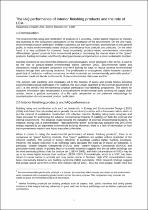JavaScript is disabled for your browser. Some features of this site may not work without it.
- ResearchSpace
- →
- Research Publications/Outputs
- →
- Book Chapters
- →
- View Item
| dc.contributor.author |
Ampofo-Anti, N

|
|
| dc.date.accessioned | 2010-07-13T13:28:16Z | |
| dc.date.available | 2010-07-13T13:28:16Z | |
| dc.date.issued | 2010-01 | |
| dc.identifier.citation | Ampofo-Anti, N. 2010. IAQ performance of interior finishing products and the role of LCA. Green Building Handbook Volume 2: A Guide to Building Products and Their Impact on the Environment, pp 358-367 | en |
| dc.identifier.isbn | 9780620452403 | |
| dc.identifier.uri | http://www.greenbuilding.co.za/content/green-building/handbooks/item/6-green-building-handbook-vol-2.html | |
| dc.identifier.uri | http://hdl.handle.net/10204/4073 | |
| dc.description | Copyright: 2010 Alive2green | en |
| dc.description.abstract | The environmental rating and certification of products is a voluntary, market-based response by industry and business to the consumer’s perceptions of the importance of the environment. On the one hand, environmental product certification enables customers, be they government, professionals or the general public, to make environmentally aware choices and influence how products are produced. On the other hand, it is very profitable for business. Most importantly, product-related environmental information differentiates “green” products from conventional products, increasing the market share of the “green” products, fuelling innovation, and thereby driving processes and products in a more sustainable direction. Societal concerns for environmental protection and conservation, which emerged in the 1970s, is said to be the root of product-related environmental claims (Johnson 2003). Environmental labels and declarations initially attracted consumers who were looking for ways to reduce adverse environmental impacts through their purchasing decisions. The proliferation of unsupported claims however caused a great deal of confusion – without consensus on what represents an environmentally preferable product, consumers could not decide on the merits of one environmental claim over another. The concern with credibility and impartiality led to the creation of public and private bodies providing environmental product certification. For instance, the Blue Angel, launched by the German government in 1977, is the world’s first environmental product certification (eco-labelling) programme. The desire for objective information also necessitated a comprehensive environmental audit covering all supply chain activity, hence a gradual acceptance of a life cycle perspective as the preferred methodology for standardisation of environmental product certification. | en |
| dc.language.iso | en | en |
| dc.publisher | Alive2green | en |
| dc.subject | Interior finishing products | en |
| dc.subject | Green buildings | en |
| dc.subject | Eco-labelling | en |
| dc.subject | Environmental product certification | en |
| dc.subject | Environmental protection | en |
| dc.subject | Environmental conservation | en |
| dc.title | IAQ performance of interior finishing products and the role of LCA | en |
| dc.type | Book Chapter | en |
| dc.identifier.apacitation | Ampofo-Anti, N. (2010). IAQ performance of interior finishing products and the role of LCA., <i></i> Alive2green. http://hdl.handle.net/10204/4073 | en_ZA |
| dc.identifier.chicagocitation | Ampofo-Anti, N. "IAQ performance of interior finishing products and the role of LCA" In <i></i>, n.p.: Alive2green. 2010. http://hdl.handle.net/10204/4073. | en_ZA |
| dc.identifier.vancouvercitation | Ampofo-Anti N. IAQ performance of interior finishing products and the role of LCA. [place unknown]: Alive2green; 2010. [cited yyyy month dd]. http://hdl.handle.net/10204/4073. | en_ZA |
| dc.identifier.ris | TY - Book Chapter AU - Ampofo-Anti, N AB - The environmental rating and certification of products is a voluntary, market-based response by industry and business to the consumer’s perceptions of the importance of the environment. On the one hand, environmental product certification enables customers, be they government, professionals or the general public, to make environmentally aware choices and influence how products are produced. On the other hand, it is very profitable for business. Most importantly, product-related environmental information differentiates “green” products from conventional products, increasing the market share of the “green” products, fuelling innovation, and thereby driving processes and products in a more sustainable direction. Societal concerns for environmental protection and conservation, which emerged in the 1970s, is said to be the root of product-related environmental claims (Johnson 2003). Environmental labels and declarations initially attracted consumers who were looking for ways to reduce adverse environmental impacts through their purchasing decisions. The proliferation of unsupported claims however caused a great deal of confusion – without consensus on what represents an environmentally preferable product, consumers could not decide on the merits of one environmental claim over another. The concern with credibility and impartiality led to the creation of public and private bodies providing environmental product certification. For instance, the Blue Angel, launched by the German government in 1977, is the world’s first environmental product certification (eco-labelling) programme. The desire for objective information also necessitated a comprehensive environmental audit covering all supply chain activity, hence a gradual acceptance of a life cycle perspective as the preferred methodology for standardisation of environmental product certification. DA - 2010-01 DB - ResearchSpace DP - CSIR KW - Interior finishing products KW - Green buildings KW - Eco-labelling KW - Environmental product certification KW - Environmental protection KW - Environmental conservation LK - https://researchspace.csir.co.za PY - 2010 SM - 9780620452403 T1 - IAQ performance of interior finishing products and the role of LCA TI - IAQ performance of interior finishing products and the role of LCA UR - http://hdl.handle.net/10204/4073 ER - | en_ZA |






